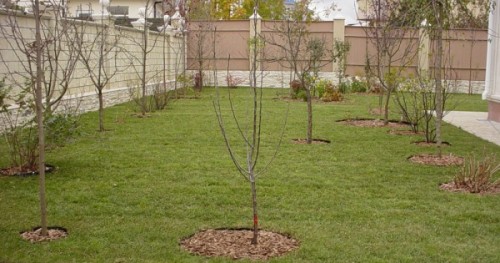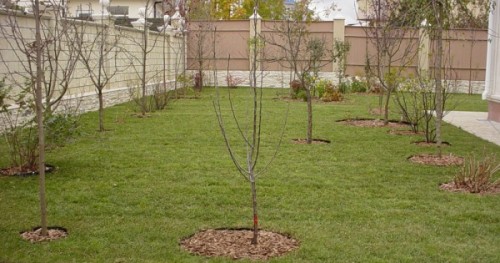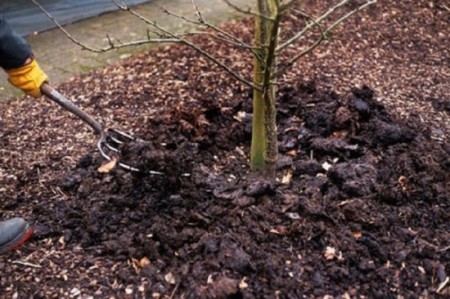The first thing a gardener should take care of is creating a strong skeleton (framework) of the crown for each tree, achieving maximum foliage of the fruit tree and maintaining it in an active state throughout the growing season, ensuring protection of the wood (trunk, skeletal and overgrowing branches) from mechanical damage, pests and diseases, as well as creating favorable conditions for the growth and development of the root system.
Young trees grow normally if annual growth reaches 50-70 cm. At the same time, they quickly form the skeleton of the crown, they have timely reserves of nutrients, which contributes to the formation of fruit formations.
Excessive growth of young trees should not be allowed, as this can lead to a delay in the tree’s entry into fruiting time and a decrease in its winter hardiness.
Young trees that do not have the vigor of the variety and rootstock may flower too early (in the second year) and produce fruit, but they will be less productive in the future.
Young trees need a large amount of nutrients and moisture, which are spent on the development of leaves and shoot growth. In the first half of summer, their growth accelerates. Therefore, they must be provided with the best conditions for food and water supply.
In the second half of the growing season, it is necessary to ensure timely completion of growth in order to ripen the wood and sufficient deposition of the necessary nutrients.
Caring for the trunk circle of young trees
In the first years after planting, fruit trees only partially use the area allocated to them. Every year, the roots of the plants grow laterally and reach their maximum size by the time of full fruiting. Consequently, soil care should consist of treating not only the tree trunk circle, but also the entire area of the garden.
During the spring-summer period, tree trunk strips or circles should be clear of weeds and other vegetation, including cultivated ones.
The size of the treated trunk circle is determined depending on the age of the fruit tree. In most breeds and varieties, the diameter of the root system is always significantly larger than the diameter of the crown.Therefore, the area of the treated tree trunk circle should always exceed the diameter of the tree crown by approximately 1-1.5 m2.
In the first two years after planting, the soil around the tree trunk must be cultivated to a width of at least 1.2-1.5 meters. And its size should be increased annually by 0.5 meters, up to the maximum development of the tree.
In autumn, after the end of the growing season, the soil is loosened on tree trunk circles (strips). The depth of processing should be no more than 8-10 cm near the stem, and 18-20 cm at the edges of the circles.
In stone fruits, the root system lies close to the surface. Therefore, the soil under them is cultivated somewhat finer. The forks and shovel should be placed under the crown, sideways to the trunk.
Before winter, it is advisable to throw the soil up to the trunk, as if pruning a tree. Careful care of the soil in the tree trunks promotes the accumulation of moisture, as well as the destruction of weeds and wintering garden pests.
In early spring, the soil is loosened by 8-10 cm to preserve moisture accumulated in the autumn-winter period. Loosening should be carried out as early as possible so as not to dry out the soil and prevent the formation of a crust on its surface. At the same time, the fruit tree trunk should be unhilled.
Fertilizing a young garden
Fertilizers promote the rapid development of fruit trees, increase winter hardiness and accelerate their entry into fruiting time. It is necessary to add nitrogen, phosphorus and potassium mainly to the soil.
The following standards are recommended for 1 m2 of tree trunk circle:
- Once every 2-3 years, add humus at the rate of up to 4 kg.
- Annually - mineral fertilizers at the rate of 5-6 g of active substance: ammonium nitrate 15-20 g, superphosphate - up to 40 g and potassium salt - 12-15 g.
If organic and mineral are added at the same time, the rate is reduced by half. Organic fertilizers are best applied in the fall, covering them under digging.
Mineral fertilizers include phosphorus and potassium fertilizers in the fall. Nitrogen fertilizers are added in the spring while digging or loosening the soil.
Mulching the soil retains moisture. In dry conditions, mulching is very effective. In the spring, after the first cultivation (loosening) of the soil, the tree trunk circle is covered with humus, old leaves, small straw, and sawdust 5-6 cm thick.
In addition to preserving moisture, mulching protects the soil structure from destruction and significantly reduces labor costs for soil care, since there is no need for frequent loosening and weed removal.
In addition, mulching protects the soil from freezing and thereby helps to better preserve the root system of young fruit trees from freezing during harsh and snowless winters.
For young gardens, watering young fruit trees is a mandatory agricultural practice. During irrigation, for more efficient use of land, you can sow some agricultural crops in the rows of the garden, such as potatoes, vegetables, phacelia, and strawberries. You cannot sow corn, sunflower, sorghum, or grains.
Inter-row crops should be grown before the trees begin to bear fruit, because in a fruit-bearing garden, inter-row crops can be harmful to them.





 CUCUMBERS NEVER GET SICK, I'VE BEEN USING ONLY THIS FOR 40 YEARS! I SHARE A SECRET WITH YOU, CUCUMBERS ARE LIKE THE PICTURE!
CUCUMBERS NEVER GET SICK, I'VE BEEN USING ONLY THIS FOR 40 YEARS! I SHARE A SECRET WITH YOU, CUCUMBERS ARE LIKE THE PICTURE! You can dig a bucket of potatoes from each bush. Do you think these are fairy tales? Watch the video
You can dig a bucket of potatoes from each bush. Do you think these are fairy tales? Watch the video
 How our fellow gardeners work in Korea. There is a lot to learn and just fun to watch.
How our fellow gardeners work in Korea. There is a lot to learn and just fun to watch. Eye trainer. The author claims that with daily viewing, vision is restored. They don't charge money for views.
Eye trainer. The author claims that with daily viewing, vision is restored. They don't charge money for views. A 3-ingredient cake recipe in 30 minutes is better than Napoleon. Simple and very tasty.
A 3-ingredient cake recipe in 30 minutes is better than Napoleon. Simple and very tasty. Therapeutic exercises for cervical osteochondrosis. A complete set of exercises.
Therapeutic exercises for cervical osteochondrosis. A complete set of exercises. Which indoor plants match your zodiac sign?
Which indoor plants match your zodiac sign? What about them? Excursion to German dachas.
What about them? Excursion to German dachas.